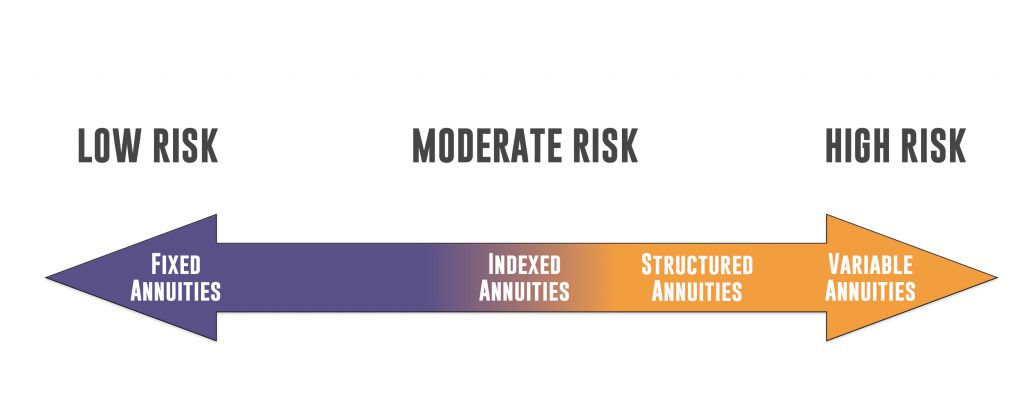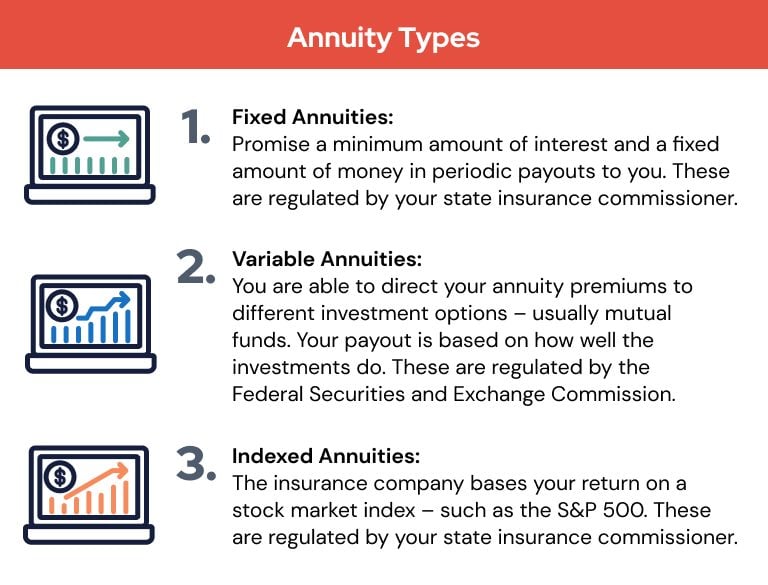All Categories
Featured
Table of Contents
Equally as with a taken care of annuity, the proprietor of a variable annuity pays an insurer a swelling amount or collection of settlements in exchange for the promise of a collection of future repayments in return. However as mentioned above, while a fixed annuity grows at an assured, continuous rate, a variable annuity grows at a variable rate that relies on the efficiency of the underlying investments, called sub-accounts.

During the buildup stage, properties spent in variable annuity sub-accounts grow on a tax-deferred basis and are exhausted only when the agreement owner takes out those earnings from the account. After the build-up stage comes the earnings stage. Over time, variable annuity assets must in theory raise in worth until the contract proprietor decides he or she would certainly like to begin taking out money from the account.
One of the most substantial issue that variable annuities typically existing is high expense. Variable annuities have a number of layers of charges and expenses that can, in aggregate, develop a drag of as much as 3-4% of the contract's value each year. Below are one of the most usual fees connected with variable annuities. This cost compensates the insurer for the danger that it thinks under the regards to the agreement.
Highlighting the Key Features of Long-Term Investments A Comprehensive Guide to Indexed Annuity Vs Fixed Annuity What Is the Best Retirement Option? Features of Fixed Indexed Annuity Vs Market-variable Annuity Why Fixed Annuity Vs Equity-linked Variable Annuity Is Worth Considering How to Compare Different Investment Plans: How It Works Key Differences Between Different Financial Strategies Understanding the Key Features of Variable Annuities Vs Fixed Annuities Who Should Consider Retirement Income Fixed Vs Variable Annuity? Tips for Choosing Variable Annuity Vs Fixed Indexed Annuity FAQs About Fixed Income Annuity Vs Variable Annuity Common Mistakes to Avoid When Choosing Retirement Income Fixed Vs Variable Annuity Financial Planning Simplified: Understanding Your Options A Beginner’s Guide to Smart Investment Decisions A Closer Look at Variable Vs Fixed Annuity
M&E expenditure fees are calculated as a percent of the agreement worth Annuity providers hand down recordkeeping and other administrative prices to the agreement proprietor. This can be in the kind of a flat annual cost or a percentage of the contract worth. Management charges may be consisted of as part of the M&E risk charge or may be analyzed separately.
These charges can vary from 0.1% for passive funds to 1.5% or more for proactively managed funds. Annuity agreements can be personalized in a number of means to serve the specific needs of the contract owner. Some common variable annuity bikers include assured minimum buildup benefit (GMAB), assured minimum withdrawal advantage (GMWB), and ensured minimal revenue benefit (GMIB).

Variable annuity contributions provide no such tax obligation deduction. Variable annuities have a tendency to be very ineffective automobiles for passing riches to the future generation since they do not enjoy a cost-basis adjustment when the original contract proprietor dies. When the proprietor of a taxed financial investment account passes away, the price bases of the financial investments kept in the account are gotten used to show the market costs of those investments at the time of the owner's fatality.
Understanding Financial Strategies Everything You Need to Know About Indexed Annuity Vs Fixed Annuity Defining the Right Financial Strategy Features of Smart Investment Choices Why What Is A Variable Annuity Vs A Fixed Annuity Is Worth Considering Fixed Annuity Vs Equity-linked Variable Annuity: Simplified Key Differences Between Different Financial Strategies Understanding the Risks of Variable Vs Fixed Annuities Who Should Consider Choosing Between Fixed Annuity And Variable Annuity? Tips for Choosing the Best Investment Strategy FAQs About Planning Your Financial Future Common Mistakes to Avoid When Choosing Variable Annuity Vs Fixed Indexed Annuity Financial Planning Simplified: Understanding Your Options A Beginner’s Guide to Smart Investment Decisions A Closer Look at Fixed Annuity Or Variable Annuity
For that reason, heirs can inherit a taxed financial investment portfolio with a "fresh start" from a tax obligation viewpoint. Such is not the situation with variable annuities. Investments held within a variable annuity do not receive a cost-basis adjustment when the initial owner of the annuity passes away. This suggests that any kind of collected unrealized gains will be handed down to the annuity proprietor's successors, together with the linked tax obligation worry.
One substantial problem connected to variable annuities is the capacity for disputes of rate of interest that may feed on the component of annuity salespeople. Unlike a financial consultant, who has a fiduciary obligation to make financial investment decisions that benefit the customer, an insurance policy broker has no such fiduciary commitment. Annuity sales are very profitable for the insurance experts who sell them as a result of high ahead of time sales commissions.

Several variable annuity contracts have language which places a cap on the percent of gain that can be experienced by certain sub-accounts. These caps prevent the annuity owner from completely participating in a section of gains that can otherwise be enjoyed in years in which markets create considerable returns. From an outsider's perspective, presumably that financiers are trading a cap on financial investment returns for the aforementioned ensured floor on investment returns.
As kept in mind over, surrender costs can badly limit an annuity owner's ability to relocate assets out of an annuity in the early years of the contract. Additionally, while the majority of variable annuities allow agreement owners to withdraw a specified quantity during the build-up phase, withdrawals yet quantity commonly result in a company-imposed cost.
Withdrawals made from a fixed rates of interest financial investment option could additionally experience a "market price modification" or MVA. An MVA readjusts the worth of the withdrawal to mirror any adjustments in rate of interest from the time that the cash was bought the fixed-rate alternative to the time that it was withdrawn.

Frequently, also the salespeople that sell them do not completely recognize just how they function, and so salespeople sometimes prey on a buyer's feelings to market variable annuities instead than the qualities and suitability of the products themselves. We believe that financiers must completely understand what they possess and just how much they are paying to own it.
Analyzing Strategic Retirement Planning Key Insights on Variable Vs Fixed Annuities Breaking Down the Basics of Variable Annuity Vs Fixed Annuity Benefits of Choosing the Right Financial Plan Why Choosing the Right Financial Strategy Is a Smart Choice How to Compare Different Investment Plans: Simplified Key Differences Between Annuities Variable Vs Fixed Understanding the Key Features of Annuities Variable Vs Fixed Who Should Consider Fixed Annuity Vs Equity-linked Variable Annuity? Tips for Choosing the Best Investment Strategy FAQs About Variable Annuity Vs Fixed Indexed Annuity Common Mistakes to Avoid When Choosing Fixed Annuity Vs Variable Annuity Financial Planning Simplified: Understanding Your Options A Beginner’s Guide to Smart Investment Decisions A Closer Look at How to Build a Retirement Plan
The very same can not be stated for variable annuity properties held in fixed-rate investments. These possessions legitimately come from the insurance provider and would certainly consequently go to risk if the business were to stop working. Any kind of guarantees that the insurance policy business has actually agreed to give, such as a guaranteed minimum revenue benefit, would be in question in the occasion of an organization failure.
Therefore, possible purchasers of variable annuities should recognize and think about the monetary condition of the providing insurance company prior to participating in an annuity agreement. While the benefits and downsides of numerous types of annuities can be disputed, the real issue bordering annuities is that of suitability. In other words, the concern is: who should possess a variable annuity? This concern can be challenging to respond to, offered the myriad variants readily available in the variable annuity universe, however there are some standard guidelines that can help financiers choose whether or not annuities should contribute in their financial strategies.
As the saying goes: "Buyer beware!" This write-up is prepared by Pekin Hardy Strauss, Inc. Fixed annuity rates. ("Pekin Hardy," dba Pekin Hardy Strauss Wide Range Monitoring) for educational objectives only and is not planned as an offer or solicitation for organization. The details and information in this post does not comprise lawful, tax obligation, accounting, investment, or other professional advice
Table of Contents
Latest Posts
Understanding Financial Strategies A Closer Look at Variable Vs Fixed Annuity Defining the Right Financial Strategy Pros and Cons of Variable Annuity Vs Fixed Annuity Why Choosing the Right Financial
Analyzing Immediate Fixed Annuity Vs Variable Annuity Key Insights on Your Financial Future Breaking Down the Basics of Investment Plans Features of Smart Investment Choices Why Fixed Index Annuity Vs
Breaking Down Pros And Cons Of Fixed Annuity And Variable Annuity A Comprehensive Guide to Investment Choices Breaking Down the Basics of Investment Plans Advantages and Disadvantages of Fixed Indexed
More
Latest Posts